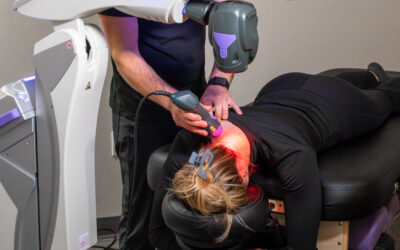 Today, we’re taking a look at how you can prevent tech neck and improve your posture in this digital age.
Today, we’re taking a look at how you can prevent tech neck and improve your posture in this digital age.
Our Phones Run Our Lives
It’s time we face it: our phones run our lives. Our devices are where we consume media, connect with people we care about, shop, date, communicate, and more.
Our lives are increasingly centered around little hand-held screens in front of us. Some studies show US consumers spend upwards of five hours a day on their phones.
And if you’re reading this, there’s a good chance you’re guilty. I know I am.
Screen Time May Be Hurting You
All this screen time may be hurting us. Hours spent hunched over our devices are compromising our posture. This leads to stiffness, soreness, and injury. Over time it can lead to worse, lifelong afflictions.
This condition is called “Tech Neck” (the clinical diagnosis is a forward head carriage, a factor in upper crossed syndrome). Symptoms can include neck soreness, pinching, and burning sensations. Migraine headaches are also associated with Tech Neck.
Avoid Unrealistic Solutions
You’ve probably heard, “Bring your phone up to eye level” or “Limit your screen time.”
There’s no doubt that’s great advice, but it’s not realistic. Have you ever seen anyone Instagramming or responding to an email with perfect posture, holding their phone above their chin?
I think bigfoot sightings are more common. Yes, this is good advice. However, it will affect zero change in the people who need help.
Weak Muscles Are The Culprit
The real cause of neck and lower back pain from phone and computer usage is weakness in muscle systems. To fix or avoid Tech Neck, you must increase your muscular capacity to hold your head in a healthy position for long periods of time.
If your deep neck flexors and mid-back muscles are weak, they fatigue quickly and begin to tighten to support your body position.
This tightness can lead to pain between the shoulder blades and up to the base of your head.
This is where the vicious cycle of discomfort begins. You feel discomfort, so you stretch the muscles. The stretch helps for a short while, but the weak muscles tighten up again.
Discomfort kicks in, and around we go.
The Solution to Tech Neck
It’s time for a modern approach to preventing tech neck in the digital age.
That means building strength.
Strength rules, and if you keep your muscles strong and flexible, they are going to be less likely to become short and cause you pain.
4 Simple Exercises to Fix Tech Neck
Below are four simple exercises you can do at home that require zero equipment and about four minutes of your time.
All you need is a little motivation. Remember, this is about injury prevention.
If you are feeling good and aim to prevent neck pain down the road — this is for you! Please share with your friends as well.
You will be a HERO!
Cat Cow
This is a good drill to restore range motion in the spine. If you spend most of your day in a single position (sitting, perhaps?), your body can become stiff, rigid, and susceptible to poor mechanics injury.
This is a great stretch for your abs and muscles that run along your spine. Focus on the breath while performing this movement, and goooo sloooowww.
Wall Angels
We spend our lives with our hands in front of our bodies. Therefore, muscles like your pecs can become tight, and you can lose important extension in your mid back and external rotation in your shoulders.
The wall angles help place you in a position where your lower back and neck are locked into position. Thus, encouraging your mid back to actively extend and your pecs to lengthen. This might look easy but get ready to feel the fatigue.
Thoracic Archers
In addition to promoting mid-back extension with the wall angels, the thoracic archers help promote rotation.
This is a great drill for restoring full movement in your mid back while stretching the pecs, biceps, abdominals, and even the front of your neck.
Additionally, establishing more movement in the thoracic spine can help promote more control around your lower back. If your thoracic spine is moving well, your lower back may not have to compensate.
Chin Tucks
Any muscles that are stretched out for a long period of time can become weak. We are talking days/ months/ years here. The stabilizers of your cervical spine are no different. When your mid back is rounded and stiff, and your head is jutted forward, the stabilizers that support a healthy head position become lengthened and weakened over time.
The chin tucks help restore a good position by engaging the deep cervical neck flexors and lengthening the extensor group at the base of your head. This creates balance… and all research has concurred that balance is a good thing.
Think You Have Tech Neck?
If you already have neck pain, or if it hurts when you do these movements, they might not be appropriate for you. Consider making an appointment at Tangelo in Seattle & Portland to assess your issues and create a custom rehab program for you.
And I promise we won’t tell you to cut down on screen time 😉


